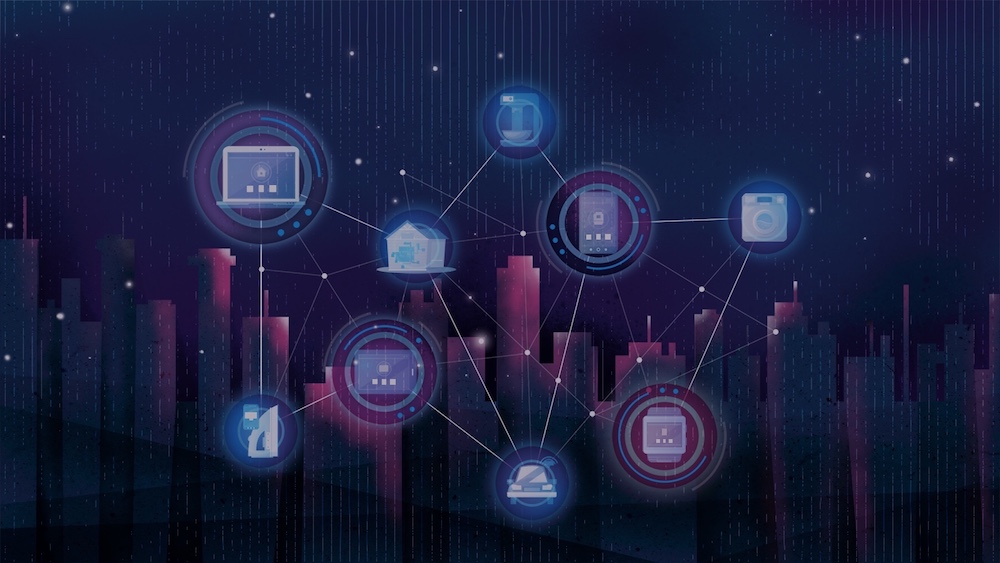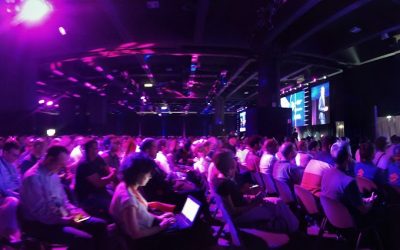The Internet of Things has the potential to change the world, just as the Internet did. Maybe even more so. – Kevin Ashton
IoT is one of the most interesting repercussions of Industry 4.0. Also called the Internet of objects, in the contemporary technological context, is still a very much-discussed topic, which will be analyzed even more in 2020.
IoT started its existence back in the ‘90s and it has continued to evolve. Its potential can be applied boundlessly and it has a pretty big importance on the competitiveness of businesses, the quality of life and the efficiency of the public administration.
A big range of gadgets, sensors, vehicles, appliances, softwares and many more have helped and contributed to increase both the productivity and the profitability whilst reducing the margin of human mistakes.
According to research by Gartner, there will be more than 20.8 billion connected devices by the end of 2020. This implies that in the new decade we will bring a completely transformed digital ecosystem with us. It will therefore be imperative for companies that want to emerge to priorityze the investments in technology.
Given the frenetic pace with which IoT is catching on, it becomes essential to keep track of the trends that will conquer the market during 2020. Data and statistics are definitely showing the following trends:
- IoT and security
- IoT in the manufacturing field
- Iot and Big Data
- Iot and Artificial Intelligence
- Iot and Smart city
1 – Focus on Security
One of the topics which will be highly discussed and analyzed not just in 2020 but also in the years to come, is the one about the implications of privacy and security. The market of connected devices is growing significantly – in 2019 the total number of devices was more than 26 billions – and, with more data available, this always equals to more risk.
The market of IoT technology will soon have to face a renewed attention strictly linked to the challenges which the diversified and distributed nature of such technology bring with them. The relationship between IoT and data protection is becoming more and more controversial and the network of devices connected is still vulnerable to the different attacks. Devices and IoT will be targeted more and more in the near future.
Governments are working hard to establish new norms and laws for granting security on all projects related to IoT: this translates into an absence of malfunctioning or abuses for citizens. Regulations which are GDPR and Cybersecurity Act compliant will give a very big contribution to the cause.
The IoT market has started to tickle hackers’ interest in the last few years. This has involved not just the data space but also remote attacks to give commands (just in the first trimester of 2018 the number of attacks has tripled since 2017).
In the development of mobile applications based on IoT, the implementation of security-related functionalities makes the authentication of each device necessary – together with biometric recognition and other mechanisms which allow a safer control of the device for the user.
Solving issues related to cybersecurity in a fast way will give a remarkable competitive advantage for IoT providers which will improve the number of sales of the different devices, specifically for end-to-end solutions.
Key takeaways:
- The diversified and distributed nature of IoT is causing a lot of security issues.
- The IoT technology market will intensify the attention on security and privacy.
- Providers of end-to-end IoT solutions will benefit from security challenges to IoT.
2 – IoT in the Manufacturing field
The advantages and the results that the full use of IoT technologies offer to manufacturing are quite tangible. For example, in different factories, IoT has found its purpose in wearable devices, giving workers a very clear picture of the conditions and the security in which they work. At the same time, such devices can quickly connect managers and users. The system improves the way the time is handled with a relevant reduction of inactivity and improves security as well giving constant feedback to collegues.
Data can be then collected and organized, helping with precautionary maintenance, one of the sectors that is evolving more and shows no sign of stopping. IoT has therefore brought industrial standardized automation for the infrastructure system which is also very flexible.
People are already starting to talk about IIoT (Industrial Internet of Things) in companies which are already investing to create an innovative infrastructure. The opportunities and the results of IoT in the manufacturing industry also include the improvement of time-to-market, the reduction of TCO, the management and the abatement of operational risks.
During the next few years, the devices connected will go way beyond the “personal space” and office/company in order to shift towards bigger domains such as telco, transportation, agriculture etc – all trying to solve the critical points in these areas.
Key takeaways:
- IoT found its way inside smart organizations.
- IoT can help managers to foresee machinery problems.
- IIoT is almost there.
3 – IoT and Big Data
The evolution of IoT has brought a huge quantity of data that was never seen before. This allowed to analyze and identify how the devices are used and the people who use them. Having to deal with so much info means defining key strategies which can give value to Big Data, converting them into something very precious for the business.
2020 will see a steep increment of investments from both small and big organisations, especially for Big Data Analytics in five areas mainly: process optimisation, new generation of products and services, product/services personalisation, data monetisation and commerce/advertising.
Valorising the data collected from IoT devices goes hand in hand with the opportunity of extrapolating useful information. This is where Artificial Intelligence plays a fundamental role. On the market there are different solutions which can easily integrate advanced platforms for analyzing data that operate on AI algorithms.
Key takeaways:
- IoT has brought a huge quantity of data.
- Steep increment of investments in Big Data Analytics.
- New advanced platforms for analyzing data that operate on AI algorithms.
4 – Artificial Intelligence will become very important with IoT
As mentioned before, Artificial Intelligence is bringing some new nourishment to the connected devices and, together with Machine Learning and other AI learning techniques, such positive jump can only increase. The trend will continue to grow during next year, bringing some new interesting developments. Applications that integrate AI and IoT are not important just for retail but also for businesses, homes and cities since it has a radical impact on public companies and consumers.
Different techniques of AI will be used to analyze the huge amount of data gathered through IoT devices. Since AI is an automated learning system, it can discover in a very fast way the tendencies happening in that very moment – allowing data analysis and augmented decisional processes.
In the near future, the fusion of AI, Big Data and IoT will simplify the management of the connected devices, opening the path to a new optimized and maximized generation experience for final users.
The latest news are all about very detailed analysis of info generated by the connected devices to implement Advanced and Predictive Analytics. Before deep-diving into IoT, organisations will need to take into consideration the actions to implement regarding privacy and cybersecurity whilst defining the roles and responsibilities of AI.
Key takeaways:
- IoT Analytics will be more and more used in IoT networks.
- Flows of data are now integrated with Machine Learning and AI.
- Integrated Analytics helps IoT solution providers to quicken the analysis of data.
5 – Smart Cities: smart developments
The Smart City concept is associated with the idea of the city of the future and it is not just about making people’s lives comfortable. It is also about improving social, environmental and financial aspects of the urban life. From a global perspective the podium sees Barcelona and London in third and second place and Singapore in first place. Since Singapore it is a state-city, it is now aiming to become the first Smart Nation ever.
Smart City is starting to become a reality in our own country too. Milan and Turin are working on some large-scale projects and Verona is installing traffic signals which give priority to ambulances. Generally speaking, the number of municipalities implementing innovation challenges for the urban context is still small.
This is due to scarce economic resources and the lack of adequate competences but also for not having enough clear governance models.
Looking abroad again, the race to Smart cities will mean, in the next few years, a technological expense, which might cost up to $80 billion by 2050. This is due to the fact that the more the population of the city grows, the more the Smart City will be a key ingredient to improve sustainability and quality of life.
The tools to collect info such as surveillance cameras, video booths etc will be connected to the internet, allowing an easy exchange of data. This will bring a better life style, more security and development, and a more controlled traffic. The Smart revolution will not just be limited to one city but it will also heavily touch homes, offices and businesses.
Key takeaways:
- IoT adoption will help Smart Cities.
- The technology expense for Smart Cities will multiply.
- Intelligent cities will play a key role in improving sustainability and the quality of life.
How can such trends help your business?
The trends mentioned above help to demonstrate that IoT is beginning to mature and, in the next few years, it will see a huge change which will make our lives easier, more comfortable and safer. The future of IoT app development is so promising that we will start seeing modernised versions of IoT soon such as Industrial IoT (IIoT) and Internet of Everything (IoE).
In such a context how can we make sure your business is ready to adopt IoT in the best way possible? Many of us are not ready to face this IoT revolution: no limits exist and every single object can become “intelligent”. The five trends analyzed in this article (which are just some of those that will invade the market in the years to come) can be helpulf.
The type of business doesn’t make any difference, IoT will always find its way inside your organisation. To make sure you are not left out, get in touch with an experienced IT partner who can help you in making your aspirations become reality!
You might also like:
IoT from A to Z in 4 points and 2 episodes – Part 1
IoT from A to Z in 4 points and 2 episodes – Part 2
Interlogica: IoT application in Smart working and Facility Management



